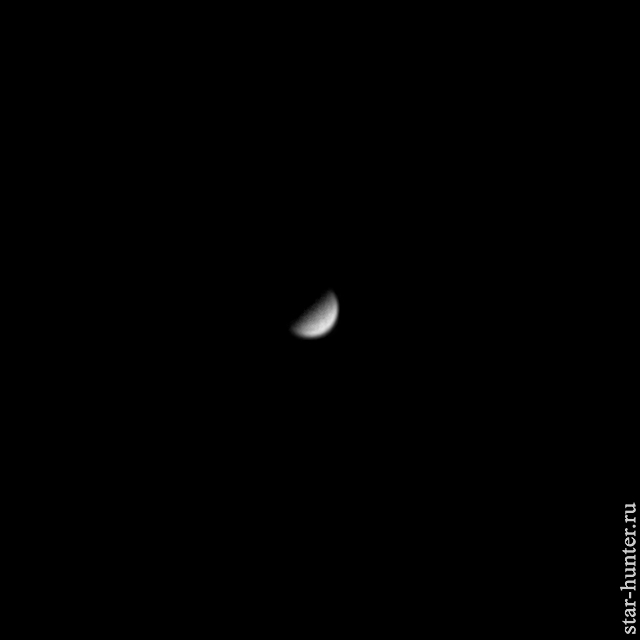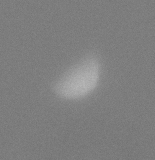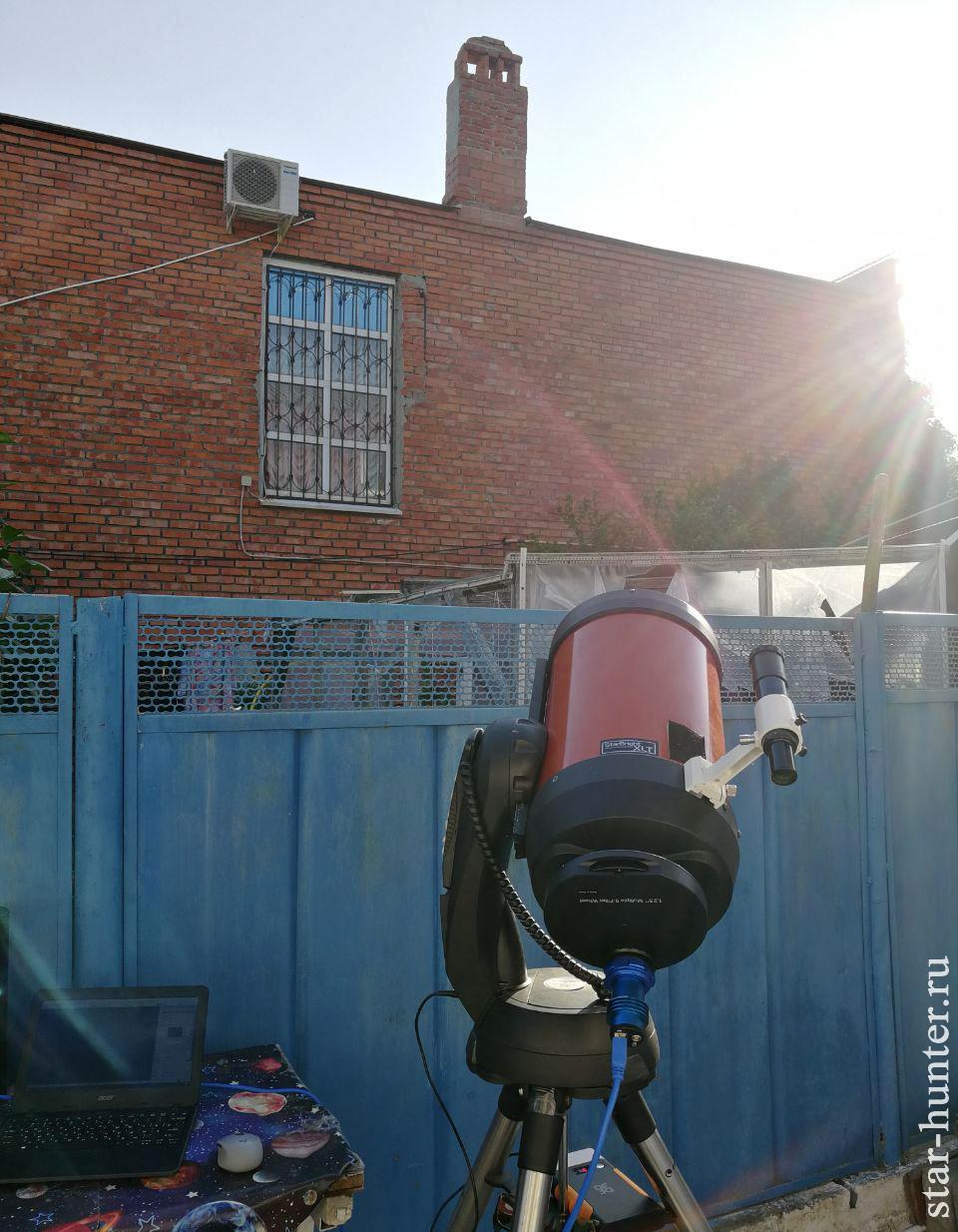In this post I will share my impressions of the daytime shooting of Mercury. I’ll say right away that this shooting turned out to be difficult for me – the scorching Sun, the planet constantly knocking out of sight of the eyepiece, about 20 alignments of the mount for the Sun, a long peering into the bright blue background of the sky really tired me. However, I still managed to catch Mercury and confidently fix its phase. I think that with a quieter atmosphere, some details of the planet’s surface can be captured.

Equipment:
-telescope Celestron NexStar 8 SE
-Barlow lens cell Sky-Watcher 2x
-filter wheel
-filter Meade CCD Red
-camera QHY5III178m (7 ms, 120 fps).
The duration of the video is 2 minutes.
Processing: PIPP, Autostakkert (stacking of 2500 frames from 14302, deconvolution).
Location: Russia, Anapa, backyard.

The difficulties are as follows:
1) The proximity of the Sun. Parasitic illumination from the Sun significantly reduces the image contrast, and can also heat the telescope tube, creating parasitic streams.
Solution: wait until the Sun hides in the shade of a house or a tree and then start shooting. Use a dewshield or hood.

2) Search for a planet in the sky.
Solution: motorized mount with Go-To system. I use the Celestron NexStar SE mount, it has a function to align with objects in the solar system. I use the Sun as this object — I install a protective light filter on the telescope, catch the Sun in the eyepiece and point the mount to the location of the Sun. If there is a Moon in the sky, you can align to it. Mercury is very low-contrast, I did not succeed in catching it in the 6×30 finder, but according to Venus, a finely tuned optical finder will greatly facilitate the search task.
If your mount is not equipped with an Go-To system, but it does have coordinate circles, you can also use it to search for daytime objects. Alt-azimuth mount must be pre-calibrated to the level of the horizon using a bubble level. You can also choose the Sun as an object of reference (do not forget about the protective filter!). The coordinates of the Sun can be taken from an software planetarium, for example, Stellarium.
In the case of an equatorial mount, you must set the polar axis of the mount in advance – for example, leaving the mount in the evening. We direct the telescope at the Sun, the DEC (declination) coordinate should coincide with the one in the planetarium, and the Ra scale (right ascension) can be adjusted to the existing coordinates.
For reducing day sky background, you can use a red filter. We put the minimum or average magnification and catch the planet in the eyepiece. Daytime Mercury through a telescope looks like a tiny circle or sickle (depending on the current phase). At first glance, to see it is very difficult. At the same time, Venus immediately catches the eye due to the high brightness. In this regard, the search for Venus is much simpler than Mercury, since it is even brighter and moves further from the Sun in the sky (up to 47 degrees). Similarly, you can find Jupiter, Mars, bright stars (Sirius, Vega, Arcturus).
3) Heat flows from the Earth. During the day, the earth’s surface warms up, warm air rises, creating additional distortion of the image.
Solution: shoot in the morning (with suitable elongation), or in case of weather with variable cloudiness. When shooting with a monochrome camera, you can use red or IR-pass 680…720 nm filters. For color cameras with high sensitivity in the infrared range (sensors Sony imx224, imx290) you can use the IR-pass filter 850 nm. Shooting in the red and infrared ranges noticeably reduces visible atmospheric fluctuations. High-speed shooting will also be useful (from 50 to 150 frames per second), as it is more likely to catch a quiet moment of the atmosphere. On bright Venus, you can increase the recording speed to 200-400 frames per second. The duration of shooting on azimuthal mounts is limited to a few minutes due to the effect of field rotation. The owners of equatorial mounts can shoot Mercury and Venus much longer, gaining a sufficient number of clear frames for addition.
4) Focusing. Before searching, it is better to pre-focus on a very distant object or the Sun, and then look for a planet. Catching the planet itself with a camera is also very difficult – I recommend installing a Barlow lens and an eyepiece, catching the planet, focusing roughly and then installing a camera instead of an eyepiece.
I focus on the laptop screen, slightly unscrewing the focus of the telescope “for infinity”, in order not to take atmospheric turbulence for details, and then I catch the most dramatic image of the planet.
When shooting during the day, I recommend to ensure good protection against overheating. To improve the visibility of the laptop screen, its case can be covered with a large box with a hole.
I hope that my shooting experience and recommendations will help you successfully find Venus, Mercury and other celestial objects in the daytime sky. Have questions or recommendations? Want to share your own experience? Write in the comments.
Собственно и интересуюсь – насколько актуальны наблюдения/фото внешних планет при освещении близком к дневному. В 04:30 к примеру Юпитер у нас забирается достаточно высоко, но можно ли на нем будет что-то увидеть?
Добрый день! Скажите, а насколько хорошо видны утром/днём внешние планеты – Юпитер, Сатурн. В наших широтах они до августа на приличной высоте только в светлое время суток, к сожалению.
Здравствуйте. СПб? Условия видимости планет плохие сейчас – Юпитер, Сатурн ползут где-то на 11 градусах над горизонтом где-то в 2:30 ночи.
В конце июля темнеть будет позже, поэтому условия видимости планет немного улучшатся.
В августе Сатурн будет всё равно низко – около 15 градусов над горизонтом, а вот Юпитер будет подниматься до 30 градусов.
Да, Питер. Планирую выставиться в 02:00 когда ещё визуально видны и подождать до 04:30, весь вопрос в том стоит ли игра свеч?))
В 4:30 уже светло будет совсем, скорее всего. Пробуйте с 02:00 понаблюдать. Через месяц-другой будет видно намного лучше.
Собственно и интересуюсь – насколько актуальны наблюдения/фото Юпитера при освещении близком к дневному. В 02-03 часа наблюдал на 12 градусах, атмосфера просто кошмар, но есть ощущение что если бы планеты были выше, то было бы вполне нормально
Из дневных наблюдений планет актуальны только наблюдения Венеры. Сатурн, Юпитер, Марс, Меркурий – катастрофическое падение контраста.
Юпитер, в принципе, неплохо смотрится в сумерках – пояса при этом чуть лучше видны.
Спасибо! Сегодня как раз будет возможность оценить самостоятельно) Если с Юпитером все будет плохо, переключусь на Венеру
Jun 18, 23:00.
Меркурий:
https://www.calsky.com/cs.cgi?cha=7&sec=2&sub=1
Observable at: 23h 07m (Alt.: +5.0°, Az.: 306.1° NW, Alt. Sun: -4.6°)
Telecope required, Δ-2.1mag
Марс:
https://www.calsky.com/cs.cgi?cha=7&sec=5&sub=1
Observable at: 23h 06m (Alt.: +5.0°, Az.: 305.8° NW, Alt. Sun: -4.5°)
Telecope required, Δ-3.8mag
Марс больше,… значит ярче?
У Марса в противостоянии блеск -2.8m. Что-то тут не так.
Вы правы, это я не туда посмотрел.
На самом деле:
Mars:
Visual magnitude: 1.8 mag,
Marcury:
Visual magnitude: 0.2 mag,
Шикарный Меркурий. А я только звёздочку в SW707 видел. ?
Сегодня Марс и Меркурий можно было вместе наблюдать с небольшим увеличением. Собственно так Меркурий и легче найти: слабенькая звёздочка рядом с Марсом.
Марс сейчас вроде тусклый, 2 звездная величина. Заснять его днем будет еще той проблемой. Ближе к вечеру попробую.
Разве Марс не ярче Меркурия?
Хмм. Я начинаю путаться.. Тестирую новый телескоп, сравниваю со старым: один переворачивает, другой зеркалит..
Марс вчера и позавчера должен быть левее, а Меркурий правее? 🙂
Стеллариум говорит, что тусклее. Положение планет зависит от времени суток. Сегодня вечером Марс будет левее.